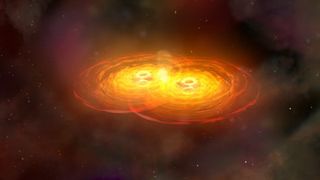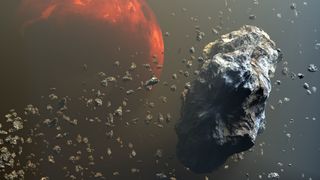Astronomy
Explore Astronomy
Latest about Astronomy

Sunspots surge to 23-year high as solar maximum continues to intensify far beyond initial expectations
By Harry Baker published
The average number of visible dark patches on the sun's surface in August was higher than any other month since September 2001. The final count was more than twice as high as experts initially predicted it would be.

Saturn at opposition: How to see the ringed planet at its biggest and brightest this week
By Gretchen Rundorff published
Saturn will enter opposition on Sept. 7 and 8, orbiting on the opposite side of Earth as the sun. Here's everything you need to know to spot Saturn at its peak size and brightness this week.

Early galaxies weren't mystifyingly massive after all, James Webb Space Telescope finds
By Charles Q. Choi published
'The bottom line is, there is no crisis in terms of the standard model of cosmology.

Space photo of the week: Milky Way's galactic twin captured by Dark Energy Camera
By Jamie Carter published
NGC 6744 is a spiral galaxy bigger than, but otherwise very similar to, our own. NASA has dubbed the large spiral galaxy the Milky Way’s ‘big brother’.

Astronomers discover new 'odd radio circle' near the center of our galaxy
By Keith Cooper published
A mysterious ring invisible at all wavelengths except radio could be a trace of a dramatically unstable star shedding its skin.

NASA discovers planet-wide electric field around Earth that's shooting bits of our atmosphere into space
By Ben Turner published
NASA scientists have discovered a planet-wide electric field surrounding Earth, confirming a 60-year-old hypothesis. Studying the field could yield some vital information about how our planet's atmosphere has evolved.

AI uncovers the universe's 'settings' with unprecedented precision, and it could help to resolve the Hubble tension
By Ben Turner published
The new AI system can estimate cosmological parameters with stunning precision, and it could help astronomers unpick one of the thorniest problems in the field.

James Webb telescope spots 6 enormous 'rogue planets' tumbling through space without a star
By Ben Turner published
The James Webb Space Telescope has uncovered six "rogue planets" careening through space without a star. The objects are believed to have formed directly from gas collapse, blurring the lines between planets and stars.
Sign up for the Live Science daily newsletter now
Get the world’s most fascinating discoveries delivered straight to your inbox.


